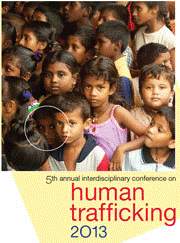Human Trafficking, Interdisciplinary Conference on

Annual Interdisciplinary Conference on Human Trafficking: 5th (2013)
Date of this Version
9-2013
Document Type
Presentation
Citation
Presented at Fifth Interdisciplinary Conference on Human Trafficking, Lincoln, NE, October 10-12, 2013
Abstract
This study is third in a series of studies that explores the little-known lives and experiences, vulnerabilities and resiliencies of sexually exploited young men in Southeast Asia. It is a part of a small, collaborative movement among interested organizations who have both recognized and acted upon the neglect of boys and men in discussions of sexual abuse and exploitation. The studies have utilized both quantitative and qualitative research methodologies, merging careful fieldwork and extensive, one-on-one structured interviews to provide a better understanding of the lives of young men and boys within the sex trade industry and an information resource for service providers.
Over the past few years, the sexual exploitation of women and girls in Southeast Asia has continued to be the subject of much research and has remained a central concern among NGOs and Anti-Trafficking in Persons organizations. Meanwhile, the sexual exploitation and violence against men and boys has been a pressing reality that has been little acknowledged, much less understood. Furthermore, of the studies that have been conducted, the prime focus has primarily remained on sexual health, rather than addressing young men as whole persons with emotions and deeper vulnerabilities. In addition to this, social and cultural norms often assume that men and boys in the sex-industry are inherently strong and/or invulnerable to sexual exploitation; however, research in this area continues to show these assumptions to be false.
In order to provide a holistic baseline of information of the young men in this industry, structured interviews were conducted with 50 male masseurs from numerous massage services in various vicinities within the Metro-Manila area known to be key to the industry including Timog Ave (QC), Malate (Manila), Diliman (QC), and Recto (Manila) areas. Vulnerabilities of these young men were assessed, particularly focusing on a number of areas including financial security, sexual health and history, experiences of violence, spiritual development and spirituality, and future plans.
This study drew male respondents from three major outlets of massage within the Metro-Manila area: massage establishments with only male masseurs (male-only establishments), massage establishments with both males and females (mixed-gender establishments), and independent (or freelance) masseurs. Nearly all, or 95 percent, of respondents indicated providing sexual services and 70% indicated meeting clients for sex within the past week. Analysis of data revealed a strong contrast between masseurs coming from the various outlets of the massage industry, and similarly divergent levels and types of vulnerability for each respective group. While masseurs coming from mixed-gender establishments had lower frequencies of meeting clients for sex, they also had the highest rates of violence from their clients. Masseurs from all outlets of massage indicate low awareness (and practice) of sexual health. Respondents from Mixed-gender establishments demonstrated significant risk in this area with 40% of respondents indicating that they had never used a condom and nearly two-thirds indicating that they had never had any sexual health services.
In addition to the quantitative assessment, this study also provides a qualitative assessment of the broader male-to-male sex industry within the Metro-Manila area, including escort services and both direct and indirect male sex work. This information serves to provide a useful background and context for the quantitative data gathered from respondents in this study.


Comments
Copyright (c) 2013 Jarrett Davis & Glenn Miles